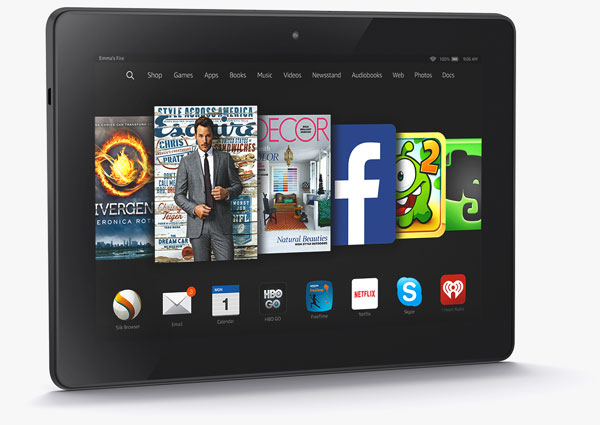
Uplinq, Qualcomm’s big — and it was big — developers’ conference, took place last week. There were two parts that were particularly interesting. One was its new robotics effort, and the other was the announcement that it’s pushing Vuforia, its augmented reality platform, into wearable head-mounted displays (think Google Glass on steroids).
Qualcomm is imagining a time when we’ll wear these things from the moment we get up until we go to bed. It will have a rather massive impact on many of the technologies we currently use — from TVs to smartphones — and it quickly could make them all. Imagine the impact an always-worn head-mounted high-definition display could have on life as we know it.
I’ll close with my product of the week: the amazing new Kindle Fire HDX 8.9 Tablet.
What if Everything Were Virtual?
Here’s the easy stuff: All the information you need is in front of you all the time and available via voice command. Appointments, email, messages, the names of people who walk up to you, street names, even the kind of car you are looking at could, based on preferences, magically pop up at the moment you need it.
Have trouble with names? You won’t anymore. The glasses will remember them for you — and not just people you have met in person, but also those who have connected to you over social media, along with the relevant information that makes them interesting.
You can immediately acknowledge you know them and ask about their spouses, children and job with instant references to guide you through the conversation.
Scared of losing your car, your kids or your parents? Your glasses can constantly show you where they are with respect to where you are and, with a command, you can be in instant communication with them. Even Star Trek’s captain of the Enterprise didn’t have it this good.
Other Displays Become Obsolete
Virtually every screen you now have becomes obsolete. Think about it. If you have a high-resolution head-mounted display with an integrated high-resolution camera, the glasses can see better than you can without them, even if you don’t have a vision problem.
You can see better at night. Arguably, you wouldn’t even need windows or a windshield in cars, planes or trains, because using cameras mounted outside you could see better than you could see if you had the windows — and without windows, all of those things become both more efficient (no window-related turbulence) and more structurally secure.
Why would you need a TV, a watch or a cellphone screen? All of those things could be virtualized in the glasses. You might paint a black patch on your wall and program the glasses to put the TV there, but you wouldn’t need to, and everyone in the room could watch a different program or the same program. In fact, you could be wrapped with other people watching the same show visually and electronically, even if they’re not in the room.
Let’s say you and your spouse want to watch different programs on TV at the same time and your buddy and his spouse, miles away, wanted to do the same thing. You and your buddy could not only view the same show, but where your spouse is sitting you could see your buddy instead — and you could converse with him just as if he were sitting next to you. Granted, it could be a bit freaky if your spouse suddenly wanted to give you a kiss.
How About Colors?
Why would you need to paint walls, have curtains (well, we already said you wouldn’t need windows) or have any colors on your furniture? You like purple? Every room you go into would be virtually rendered in pleasing shades of your favorite color. No more arguments with your spouse on colors.
If you are sun child and she is more gothic, you can see happy rooms and she can see rooms Dracula would love. The only reason you’d use paint would be to protect stuff, and the colors would be optimized for that. (I imagine it would be kind of shocking if your glasses should break or malfunction).
How About Makeup?
Why would you need to put it on? You could simply program a look and have everyone see what you programmed. Don’t like your nose or gender? You just change your virtual image and be anyone you want to be, including Batman (though I expect you’d have to license that).
The only cost would be the ever more-elaborate apps you’d purchase to implement the looks you wanted to create. Designer dresses would be programmed, not cut, and everything from your shoes to your hats would be designed for function, not appearance, because the appearance stuff would be virtualized.
Wrapping Up: Creating Un-Reality
I think we are on the early path to creating un-reality — the ability to mold our environments to better match what we want to see. The end isn’t glasses, but technology surgically implanted in our eyes so that we won’t ever experience the increasingly boring real world.
Invisibility cloaks would become possible, magic would become real, and our world would become as amazing as our imaginations.
Product of the Week: New Amazon Fire HDX 8.9

I’m a big Amazon Kindle fan. I had every version of the Kindle ever made and loved them all in their time. I’m one of the few folks that like the bigger Kindle — largely because I’m an avid reader, and the bigger screen means I don’t have to flip pages as often. It is far easier to use when I’m browsing the Web, shopping, doing email, and playing games than my smaller Kindles.
The new Kindle Fire HDX 8.9 uses Qualcomm’s top-of-the-line 805 processor, so it addresses one of the most annoying parts of the older model: slow Internet speed. However, you’ll need a MIMO router to take advantage of the speed.

Yes, for all of its wonder, the old Amazon Fire 8.9 is incredibly slow on the Web, and Qualcomm has made some big changes in its best processor in its line that addresses processor performance, graphics performance and networking speed.
The Fire HDX is lighter than an iPad because it has a magnesium, not aluminum, case. (Magnesium is both lighter and sturdier than aluminum).
When it comes to sound, the new Dolby Atmos system puts this tablet ahead of the others with a stronger amp and higher-quality sound than any other tablet. Atmos is Dolby’s new 3D technology, and it is just now moving out of theaters and into receivers — and this tablet. Atmos is pretty amazing and worth checking out for its own sake.
This new tablet has some features unique to Kindles, which include the ability to push video to your TV screen from the tablet and then use the tablet as a remote control. Lighter and far less expensive than the current-generation iPad, this is a decent value and a good addition to the Kindle family. Then again, they had me at “new Kindle,” so the new Kindle Fire 8.9 HDX is my product of the week.






















































